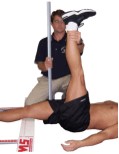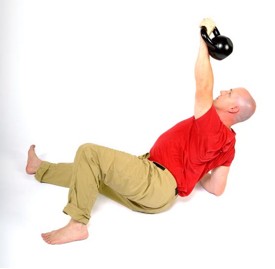Kalos Sthenos—The Get-Up
The Rationale Behind Kettlebells from the Ground Up
Brett Jones, Master RKC, CSCS, CK-FMS
February 3, 2009 03:11 PM
The term Kalos Sthenos is Greek for "Beautiful Strength" and it is where we get the word calisthenics. And it is the term that Gray Cook and I feel best represents the Kettlebell Get-Up.
While the modern definition of calisthenics refers to bodyweight exercises like push-ups, pull-ups etc… it used to mean any exercise performed with a fluid display of strength and control. And that certainly sounds like Get-Up as far as I am concerned.
The old time strongmen used the Get-Up as an "entrance exam" requiring a 100-pound Get-Up on each side before beginning any other training. The Turkish Wrestlers used the Get-Up to train for combat and grappling. And today the Get-Up represents an opportunity for everyone to regain the "beautiful strength" and symmetry that our so-called fitness routines should bring us.
So why dedicate an entire 2 DVD set and manual to one exercise? Below I will try to highlight some of the reasons why Gray Cook and I recommend the Get-Up so highly.
An assessment and an exercise…As Gray Cook has so eloquently stated — "modern fitness techniques can actually allow us to stack fitness on dysfunction." Meaning that we can actually take a "bent frame" and put a bigger engine in that car. Not a great idea. But modern fitness doesn't talk about movement and modern fitness has become a sort of sport to itself instead of being what you do to be better at a goal activity. So what is a modern fitness seeker to do?
We still need symmetry of strength and movement and the Get-Up can provide us that Left to Right assessment of movement and strength. At each of the 7 steps we use on the
Kettlebells from the Ground Up DVD you will know if the movement, stability and strength is equal. The exercise actually becomes an assessment.
 Shoulders and Hips
Shoulders and Hips"Some schools of Chinese medicine…refer to the shoulder and hip joints as the Four Knots and where there is an imbalance of tension or strength in any of the Four Knots problems…can occur…" Dr. Mark Cheng brings us this excellent description of the interplay between shoulders and the hips. Modern reductionist fitness philosophy has people attempting to isolate pieces and parts of the body into something called "fitness". But this is simply not how the body works.
Movement is an incredibly complicated concert of agonist/antagonist muscle action coordinated by a web of neurological input and… Well I could go on but to simplify we could just perform an exercise that requires us to move our body around a stabile shoulder coordinated through mobile hips, which sounds like the Get-Up once again.
 Getting Primitive…
Getting Primitive…The beginning for the Get-Up represents a very primitive rolling pattern. What do I mean by primitive? It means that very early in our developmental sequence as infants we all had to pass through this fundamental movement pattern. If we couldn't roll we might not have made it to walking. And we can actually lose this rolling pattern for any number of reasons but loss of this fundamental pattern can create a cascade effect through the body of dysfunction and compensation. Gray Cook and Lee Burton highlight these patterns in the DVD
Secrets of Primitive Patterns.
If an individual is having issues with the beginning of the Get-Up it could be because of this rolling pattern and working on the first part of the exercise can "bring back" this primitive movement pattern.
 High Threshold Strategies
High Threshold StrategiesOne of the "secret weapons" of the Functional Movement Screen group is Kyle Keisel, a Physical Therapist and researcher. The term High Threshold Strategies is a term Kyle uses to describe a dysfunctional muscle activation pattern that can be brought on by pain and distress. According to Kyle:
"The response by the CNS to increase muscle activation to the outer core muscles in the presence of pain is know has a High Threshold Strategy (HTS). Increased activation of the outer core musculature is, of course, normal for the system to manage a high load task, but in response to a painful episode or a dysfunctional inner core, it is a compensatory strategy…"
So what is Kyle referring to as the outer core and what is it balanced with? This leads us into:
"The inner core (see chart) receives ongoing subconscious input from the CNS, which automatically maintains respiration, activates the pelvic floor for continence and segmental stabilization, and activates the TrA and LM for segmental stabilization in anticipation of a spinal perturbation. This is a highly automated, delicate functioning system…"
| | Function | Structure |
|---|
| Inner Core | Respiration
Continence
Segmental stabilization | Diaphragm
Pelvic floor
Transverse abdominis
Lumbar multifidus |
|---|
| Outer Core | Postural stability
Resists external load
Movement production
Energy transfer | Erector spinea
Hamstrings
Gluteals
Latissimus dorsi
Rectus abdominis
External oblique
Tensor fascia lata/ITB
Rectus femoris |
|---|
And what does this have to do with the Get-Up? One of the differences Gray and I have emphasized in the video is the need to begin the Get-Up with a 45 degree "roll" without the down leg coming up. The lack of a roll with down leg stability can indicate that the outer core (hip flexor etc…) fired before the inner core and can demonstrate a high threshold strategy issue. When the muscles far from the spine activate first you lose any chance for true spinal and core stability.
By emphasizing the 45-degree roll and down leg stability instead of having an exaggerated heave or sit-up off of the ground you can get back to this inner core first activation.
 Conclusion
ConclusionThe systematic breakdown of the Get-Up into an exercise and an assessment through the 7 steps laid out in
Kettlebells from the Ground Up is not the only way to perform the Get-Up but it is one that we suggest as a means of checking and maintaining symmetry. When you can go through the seven steps cleanly then you can feel free to experiment and work on Get-Up variations. We should expect more from our "exercises" than a workout. We should all strive for a bit more "beautiful strength".
(Give the Kalos Sthenos a try and give us your results on the
dragondoor.com forum)
Return to Kettlebells from the Ground Up
Brett Jones, Master RKC, CSCS, CK-FMS is a Pittsburgh; Pa based fitness professional and co-author of Kettlebells from the Ground Up with Gray Cook.
Back